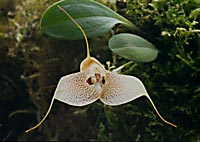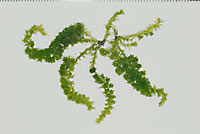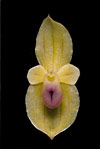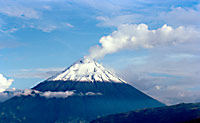A.
Lower eastern slopes of the Amazonian foothills
This
zone is extremely diverse but very poorly explored. The
trees here are tall and straight, and the forest interior
is dark and wet. Epiphytes are abundant, and orchid endemism
is higher than one would expect. The Masdevallia
at left is just one of several newly discovered orchids
apparently endemic to this zone.
B.
Upper slopes of the Amazonian foothills
The first foothills facing the Amazon are
called the Cordillera Abitagua (north of the Pastaza)
and the El Encanto mountain chains (south of the Pastaza).
This is the wettest zone of the region. It is extremely
rich in endemic species, including some that were discovered
150 years ago by Richard Spruce and never seen again.
Orchids of the genus Lepanthes are diverse here,
perhaps more diverse than in any other place of its size
on earth. Many of the orchids, such as theLepanthes
at left (which I have named Lepanthes spruceana),
are new to science. The highest peaks of this zone have
still not been explored, nor even visually mapped, because
of the ever-present fog and difficult topography.
C. The Rio Topo/
Rio Las Estancias valleys
The broad
flat valley of the Rio Topo, and its smaller counterpart
on the other side of the Rio Pastaza, supports a humid
subtropical forest with a surprising number of endemic
species of trees, shrubs, herbs, and even an endemic liverwort
discovered by Spruce in 1857 and not seen again until
Dr Gradstein, Dr. Noske, and myself recently rediscovered
it. The number of orchid species endemic to this zone
is less than the number endemic to Zone B, but there are
still quite a few. This zone is severely threatened by
deforestation and hydroelectric projects.
D. The upper Pastaza
valley and its tributary valleys
The forests here are mostly gone. Still, there
are some interesting species in this zone, including the
endemic tree Zapoteca aculeata, and an endemic
amaryllis, Phaedranassa tungurahuae.
E. Semi-arid scrub
between Baños and Ambato
It is surprising to find desert-like conditions
so close to wet cloud forest, but both are consequences
of the strong interaction of topography and wind in the
Pastaza valley. There are few plants endemic to this zone,
but it has some very interesting orchids in spite of the
dry climate. One of the most spectacular (though not endemic
to the region) is Phragmipedium lindenii, which
I have painted at left. Among the special plants of the
zone are several rare, threatened amaryllis relatives.
F. The Cerro Hermoso-Mayordomo
chain and the mountains above the Rio Cristal
This zone includes the high Llanganates mountains,
famous as the supposed burial ground of the treasure of
Atahualpa, the last Inca king. The
middle and high elevation forests of this zone are rich
in endemic orchids, all discovered in the last four years.
The genera with the most endemic species are Lepanthes
(of course) and Teagueia, but there is also a
new Maxillaria, a new Epidendrum, and
a new Ponthieva. Most of this zone is almost
impossible to reach because of the rugged terrain.
G.
The Añangu and Cerro Negro mountain chains
These mountains are remarkable for their endemic Teagueia
species (Orchidaceae). In the last year we have discovered
around 14 new species of Teagueia in this zone.
See Teagueia
Explosion! for the full story. There are
also a few newly discovered endemic Lepanthes
species, but in general the number of endemic orchids
is not as high as in the previous zones.
H. Volcan Tungurahua
and the mountains above Leito
The upper slopes of Volcan Tungurahua
are unlikely to have unique species, because of periodic
violent eruptions. The middle elevations have several
apparently-endemic orchids, though I suspect that these
will eventually turn up on other neighboring mountains.
|









